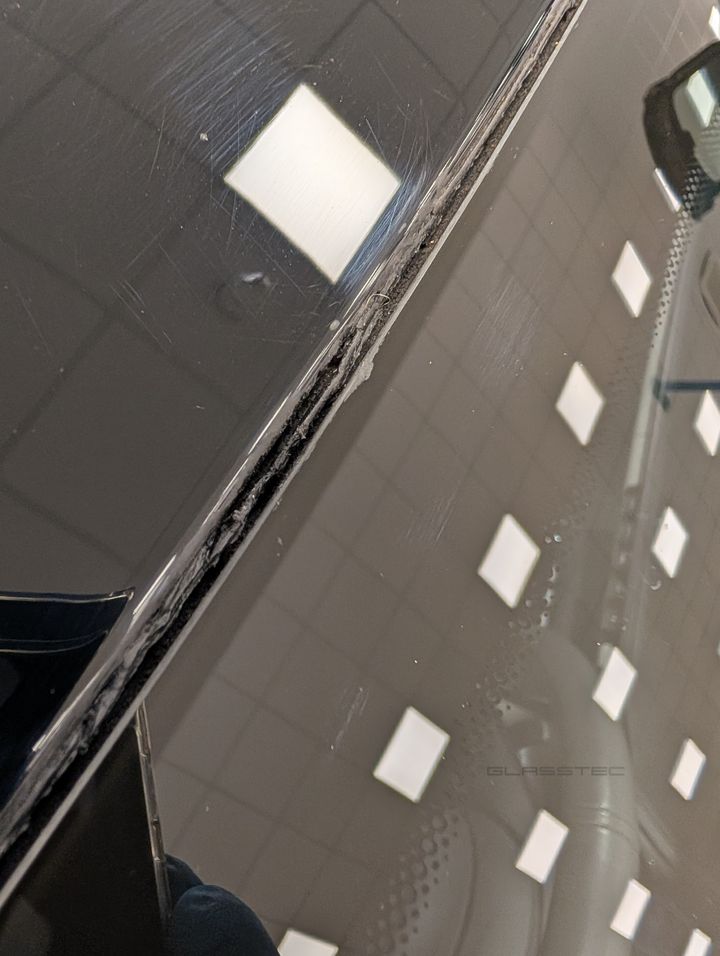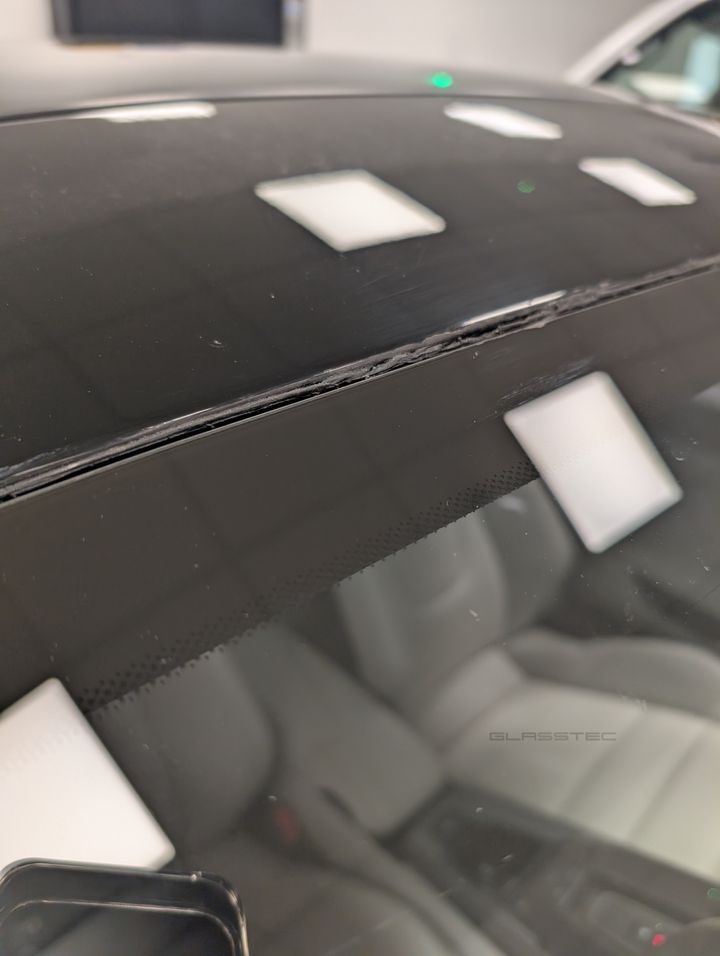Melting Trim Syndrome
Discussion
If it looks like there is wet sealant around the windscreen of a 911 (991 and 992) 718, 981 Boxster and Cayman including the 982, it is probably symptoms of Melting Trim Syndrome.

At a glance it might look like wet sealant, or excess windscreen adhesive that’s oozed out from behind. If there isn’t much of it, it might wipe away with a mild solvent. Anything more, like in the image above, it will need treating beyond cleaning or wiping. The rubber composite [the trim is made from] is breaking down. The most likely cause of this could be in its manufacture although there have been no known tests to confirm this. It could be that exposure to extreme heat and sun is attacking the chemical bond. Whilst this might explain cars in hotter parts of the world, perhaps not in the United Kingdom. A more feasible suggestion could be that a key component in the manufacturing process was not present or not enough was added to the compound mixture. It could also be that the curing mechanism in the trim during manufacture failed and has been deteriorating from the outset.

Can it be treated? First and foremost, no cause for panic! It is a cosmetic issue not a structural one. The windscreen is not about to fall out or start leaking. Contrary to some experts on social media, the structural integrity of the car is not compromised by this issue (it has nothing to do with the windscreen adhesive; that’s a completely separate [recall] issue). The trim is attached to the windscreen by means of UHB tape (at the factory) and other than providing a neat finish and keeping out dirt from the recess, it is not part of the 'seal' as such. The simple answer to the question of fixing it is: no, the trim cannot be fixed. Something within its manufacture has failed or is still failing; perhaps a UV inhibitor, polymer or curing agent.
What can be done?
There are three options:
1. Replace the windscreen (OE is the best available product).
2. Remove the existing windscreen and replace the trim with a similar profile (no OE option).
3. Wipe it, and live with it until the windscreen needs to be replaced due to wear and tear or damage.
No matter how well you can wipe the gooey, sticky residue away, it will only be temporary. The trim will continue to melt afterwards and is only be a matter of time before you are looking at a similar mess again.
It's worth asking the question to see if it's covered by warranty but to my knowledge there is no recall on this issue.
At a glance it might look like wet sealant, or excess windscreen adhesive that’s oozed out from behind. If there isn’t much of it, it might wipe away with a mild solvent. Anything more, like in the image above, it will need treating beyond cleaning or wiping. The rubber composite [the trim is made from] is breaking down. The most likely cause of this could be in its manufacture although there have been no known tests to confirm this. It could be that exposure to extreme heat and sun is attacking the chemical bond. Whilst this might explain cars in hotter parts of the world, perhaps not in the United Kingdom. A more feasible suggestion could be that a key component in the manufacturing process was not present or not enough was added to the compound mixture. It could also be that the curing mechanism in the trim during manufacture failed and has been deteriorating from the outset.
Can it be treated? First and foremost, no cause for panic! It is a cosmetic issue not a structural one. The windscreen is not about to fall out or start leaking. Contrary to some experts on social media, the structural integrity of the car is not compromised by this issue (it has nothing to do with the windscreen adhesive; that’s a completely separate [recall] issue). The trim is attached to the windscreen by means of UHB tape (at the factory) and other than providing a neat finish and keeping out dirt from the recess, it is not part of the 'seal' as such. The simple answer to the question of fixing it is: no, the trim cannot be fixed. Something within its manufacture has failed or is still failing; perhaps a UV inhibitor, polymer or curing agent.
What can be done?
There are three options:
1. Replace the windscreen (OE is the best available product).
2. Remove the existing windscreen and replace the trim with a similar profile (no OE option).
3. Wipe it, and live with it until the windscreen needs to be replaced due to wear and tear or damage.
No matter how well you can wipe the gooey, sticky residue away, it will only be temporary. The trim will continue to melt afterwards and is only be a matter of time before you are looking at a similar mess again.
It's worth asking the question to see if it's covered by warranty but to my knowledge there is no recall on this issue.
Youforreal. said:
Have you see this on 992 as well?
Is it all of a sudden or develops over a long period?
I’ve a 981 gt4 from new and it’s windscreen trim is as new, lives in a garage tbf but this is the first I’ve ever heard of this issue.
Looks like the car was cleaned with a Brillo too, just saying.
That *was* a 992. Is it all of a sudden or develops over a long period?
I’ve a 981 gt4 from new and it’s windscreen trim is as new, lives in a garage tbf but this is the first I’ve ever heard of this issue.
Looks like the car was cleaned with a Brillo too, just saying.
Yes, I think a few attempts at cleaning the bitumen were made by someone before the windscreen was replaced.
andygo said:
Would removing the screen, cleaning it, then rebonding it not sort the issue, especially if fitting a new screen works?
The trim and windscreen are one. It's how they're manufactured. The trim is not available as a separate part. I've removed broken screens and kept the trim for these situations, but there are similar profiles that can be used. Glassman said:
The trim and windscreen are one. It's how they're manufactured. The trim is not available as a separate part. I've removed broken screens and kept the trim for these situations, but there are similar profiles that can be used.
Like most specialist parts, windscreens are another bl;ack art it would seem.I have revcently had a new screen in my CGTS, so hopefully I'm OK, but interesting info nonetheless.
I have seen a few of these lately - usually noted during prep but have seen a few drive-ins for inspection. Two cases in the last 3 months I'd say.
Initially my thoughts were a chemical reaction between a cleaning product and the seal; replacement of the screen was a resolution and it went no further - as repairer we have no control over the prior use of cleaning products and or washer fluid strength for instance.
Have you seen trends with a particular screen manufacturer which might dissuade from a 3rd party influence?
Initially my thoughts were a chemical reaction between a cleaning product and the seal; replacement of the screen was a resolution and it went no further - as repairer we have no control over the prior use of cleaning products and or washer fluid strength for instance.
Have you seen trends with a particular screen manufacturer which might dissuade from a 3rd party influence?
Gassing Station | Porsche General | Top of Page | What's New | My Stuff




